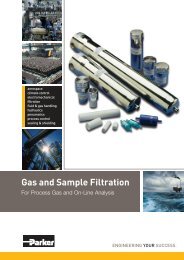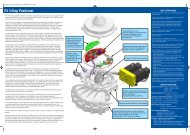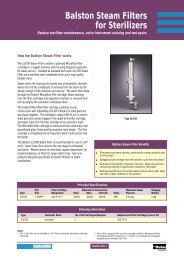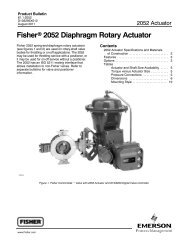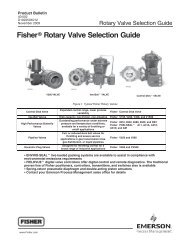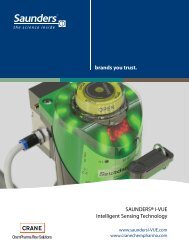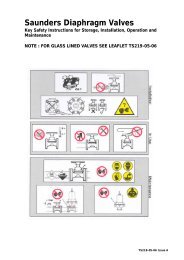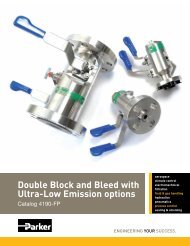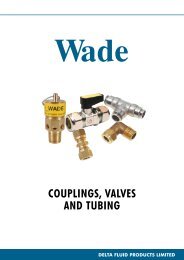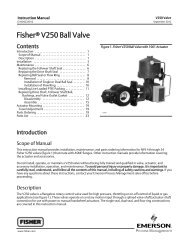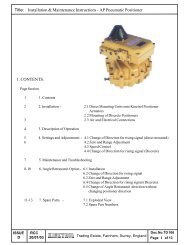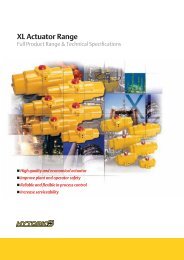Fisher® FIELDVUE DVC6200 Digital Valve Controller
Fisher® FIELDVUE DVC6200 Digital Valve Controller
Fisher® FIELDVUE DVC6200 Digital Valve Controller
Create successful ePaper yourself
Turn your PDF publications into a flip-book with our unique Google optimized e-Paper software.
Instruction Manual<br />
D103605X012<br />
Glossary<br />
July 2012<br />
Glossary<br />
Alert Point<br />
An adjustable value that, when exceeded,<br />
activates an alert.<br />
Algorithm<br />
A set of logical steps to solve a problem or<br />
accomplish a task. A computer program contains<br />
one or more algorithms.<br />
Alphanumeric<br />
Consisting of letters and numbers.<br />
Analog Input Units<br />
Units in which the analog input is displayed and<br />
maintained in the instrument.<br />
ANSI (acronym)<br />
The acronym ANSI stands for the American<br />
National Standards Institute<br />
ANSI Class<br />
<strong>Valve</strong> pressure/temperature rating.<br />
Bench Set<br />
Pressure, supplied to an actuator, required to<br />
drive the actuator through rated valve travel.<br />
Expressed in pounds per square inch.<br />
Byte<br />
A unit of binary digits (bits). A byte consists of<br />
eight bits.<br />
Calibration Location<br />
Where the instrument was last calibrated; either<br />
in the factory or in the field.<br />
Configuration<br />
Stored instructions and operating parameters for<br />
a <strong>FIELDVUE</strong> Instrument.<br />
Control Loop<br />
An arrangement of physical and electronic<br />
components for process control. The electronic<br />
components of the loop continuously measure<br />
one or more aspects of the process, then alter<br />
those aspects as necessary to achieve a desired<br />
process condition. A simple control loop<br />
measures only one variable. More sophisticated<br />
control loops measure many variables and<br />
maintain specified relationships among those<br />
variables.<br />
Control Mode<br />
Defines where the instrument reads its set point.<br />
The following control modes are available for a<br />
<strong>FIELDVUE</strong> Instrument:<br />
Analog The instrument receives its travel set<br />
point over the 4‐20 mA loop.<br />
<strong>Digital</strong> The instrument receives its set point<br />
digitally, via the HART communications link.<br />
Test This is not a user‐selectable mode. The Field<br />
Communicator or <strong>Valve</strong>Link software places the<br />
instrument in this mode whenever it needs to<br />
move the valve, such as for calibration or<br />
diagnostic tests.<br />
Control Mode, Restart<br />
Determines the instrument control mode after a<br />
restart. See Control Mode for the available restart<br />
control modes.<br />
<strong>Controller</strong><br />
A device that operates automatically to regulate a<br />
controlled variable.<br />
Current‐to‐Pressure (I/P) Converter<br />
An electronic component or device that converts<br />
a milliamp signal to a proportional pneumatic<br />
pressure output signal.<br />
Cycle Counter<br />
The capability of a <strong>FIELDVUE</strong> instrument to record<br />
the number of times the travel changes direction.<br />
The change in direction must occur after the<br />
deadband has been exceeded before it can be<br />
counted as a cycle.<br />
91



